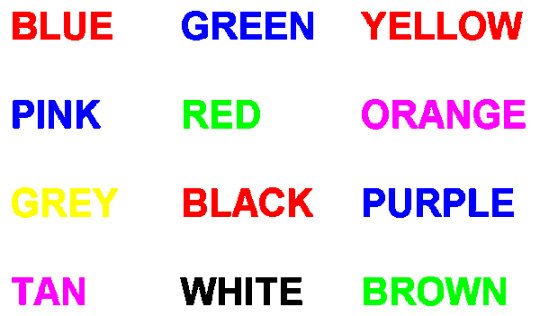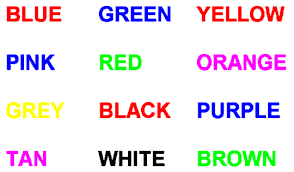
During my live workshops, I often give exercises and demonstrations illustrating how what you focus on makes a difference.
Change your focus, change what you see.
You can miss great things in life when you’re not looking for them. Or you may miss someone else’s point completely because all your attention is on only yours. In other words, if you’re focusing completely on thought A, you won’t see thought B. It’s just not going to happen–and that can limit your perspective, opportunities, and attitude.
Want to test yourself right now?
Give yourself 5 seconds. From the image below, quickly say each color aloud — the color, not the word — got it? Go!
How’d you do? How much time did you take to get it right? This is called the Stroop Test, and it’s tough!
This seemingly simple test demonstrates two powerful psychological terms. One is, “selective attention” and the second is, “response inhibition”. These two combined factors play a big role in your decision-making ability.
SELECTIVE ATTENTION
Selective attention is all about focusing on the right things, that is, your goals and the tasks that move you forward in the direction you want to go. It helps you to stay on task, to block out the cues that tempt your attention away.
This principle applies to your workplace communication. Before you engage in a tough communication, focus on the end state. In other words, your goal. Concentrate on the relationship that you hope to have after the exchange is over. Conduct your communications to support that goal. Choose to give your attention to everything in your environment and within your control that will contribute to that end. Notice, be aware, and take action. That’s how you see the opportunities.
RESPONSE INHIBITION
Your response inhibition is what helps you to control your impulses, such as saying the wrong thing or your inclination for inaction such as saying nothing at all. Your impulse might be something socially unacceptable, non-politically correct, or actually inaccurate (like saying the word versus the actual color). These inappropriate responses that are suppressed generally interfere with goal-directed actions. They’re not your friends. On the other hand, suppressing the wrong words and actions gives you control over your communications and leads you in the direction you really want to go.
It’s a classic test of “response inhibition”.
The trick in this exercise is to respond quickly while avoiding the impulse to say a wrong answer. This shows how the response inhibition helps you to tune out impulses that may interfere with you accomplishing your goal-driven tasks.
I’m guessing that this “response inhibition” is greatly affected through certain conditions such as dementia and Alzheimer’s, which my mom suffered from. Yup, that good ol’ social veneer was ripped off completely and poor mom would come out with the most inappropriate comments about people’s physique, choice of clothing and yes, even body odor. We learned to take it in stride, knowing that this was her illness speaking, not the prim and proper lady we called “mom”. Humor helps :o)
Lack of response inhibition applies to you too.
It means that without it, your natural tendencies and temptations aren’t kept in check, you end of saying or doing the wrong thing, something that steers you away from your actual goals. When combined with inappropriate selective attention, that is, focusing on the wrong things that don’t contribute to your goals, you have havoc and little chance of actually communicating in a way that best serves you and others.
Here’s how you can move this research to action in your life and your workplace communication:
- Define your end state you desire (your goals) in terms of the type of relationship you hope to have with the person you’re connecting with;
- Focus on the things that support the end state;
- Keep your end state top-of-mind and let it guide all your interactions;
- Be aware of your impulses and control them. Instead of blurting things out, remind yourself that it doesn’t serve you well. It might feel good for a second, but if it doesn’t support your overall goals, don’t say or do it.
The skill is in responding quickly while avoiding inappropriate impulses, and like any skill, it can be learned … if you’re willing. Are you?
©2021 Marion Grobb Finkelstein
Until next time, here’s to …
Better communication, Better business, Better life,
Marion Grobb Finkelstein
COMMUNICATION CONSULTANT
Keynote Speaker / Corporate Trainer / Author
www.MarionSpeaks.com
Marion@MarionSpeaks.com
www.facebook.com/MarionSpeaks
www.linkedin.com/in/MarionSpeaks
Sign up for “Marion’s Communication Tips” at www.MarionSpeaks.com
LET’S GET THE CONVO STARTED!
Post your comments and reactions below. There are no right or wrong responses, just honest, respectful ones. I’d love to hear your opinion. What about this article resonated with YOU?




Hi Marion! Thank you for this article on “Is your focus helping or hurting your communication?” It makes a lot of sense, and I particularly liked the colour game. I did it and was able to respond the correct way, but it needed some concentration. At the end, when you say “The skill is in responding quickly while avoiding inappropriate impulses, and like any skill, it can be learned … if you’re willing. Are you?”, that makes total sense, and yes I’m willing, but feelings embark when responding fast. I would have liked to have some tips on “how to…”
Many thanks! And wishing you a peaceful and lovely Christmas. Carole
Carole, thx for your comments. Yes, you can change behaviour if you really want to do so. Often, the motivator in doing so is acknowledging what you will lose if you don’t (e.g., opportunities, relationships, learning, etc.)